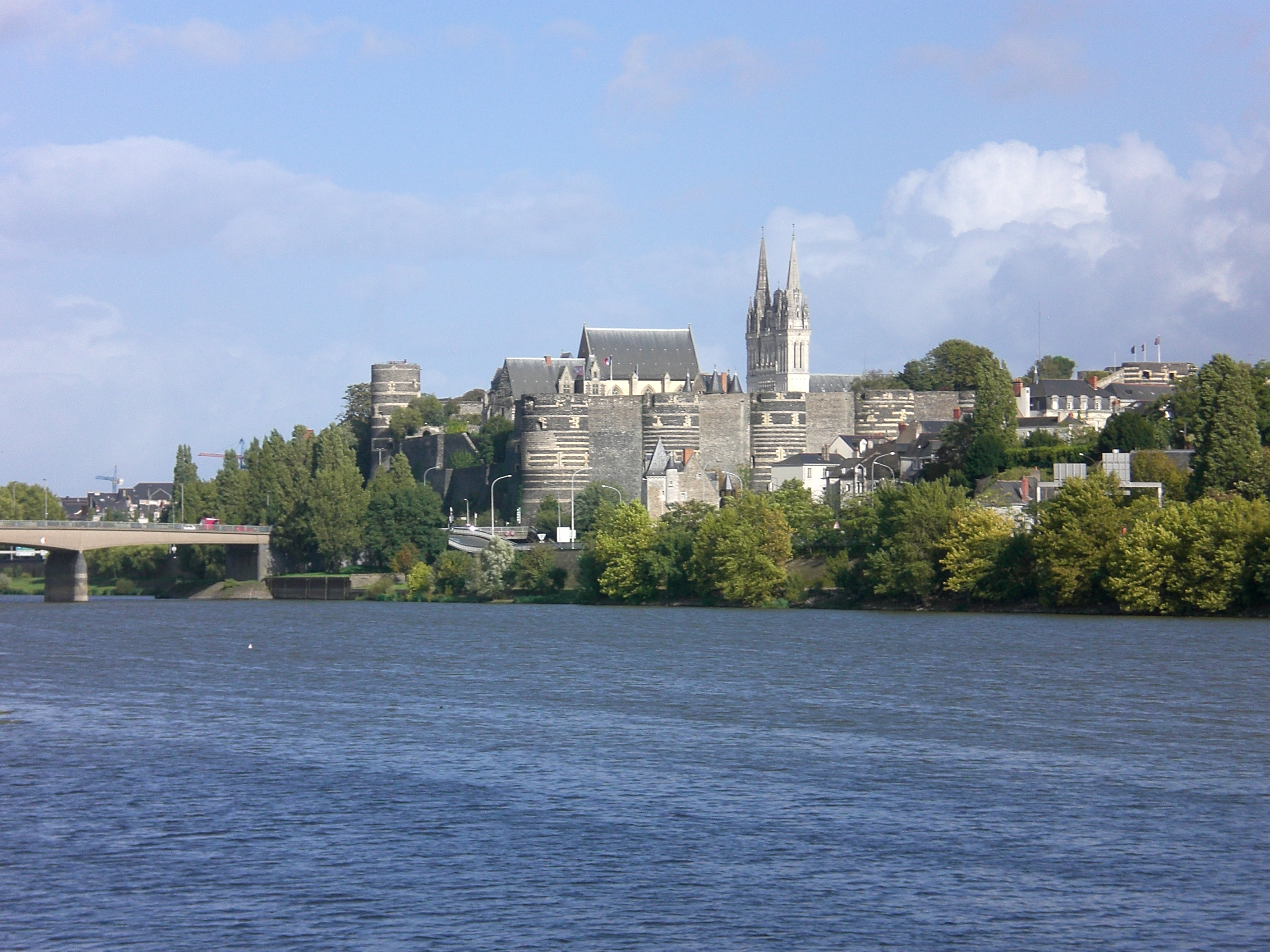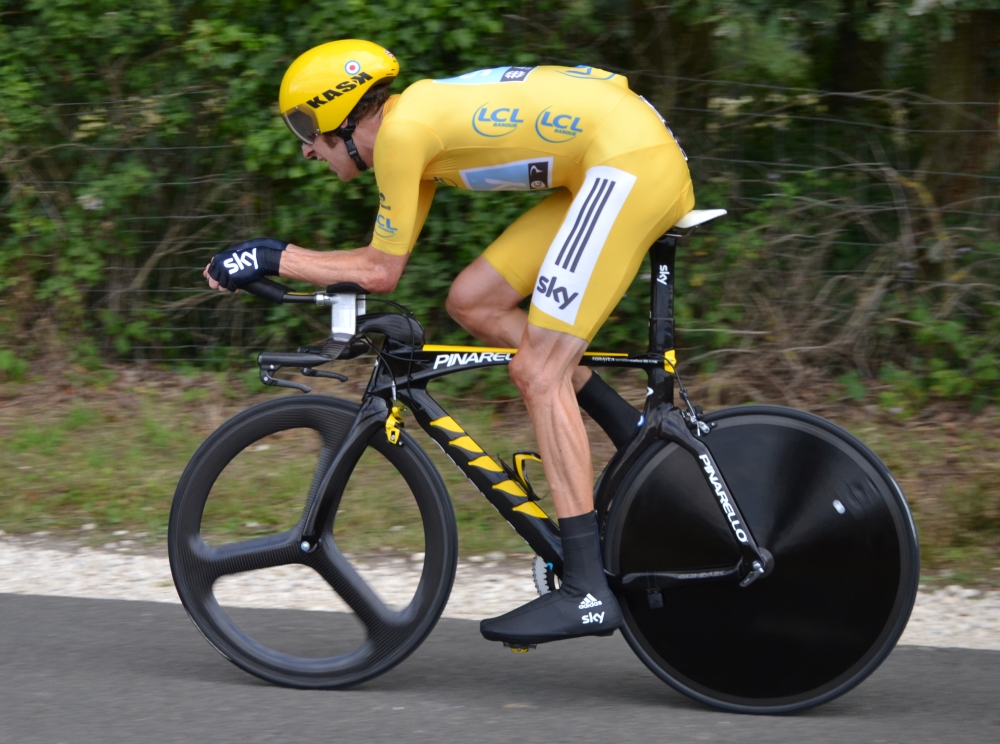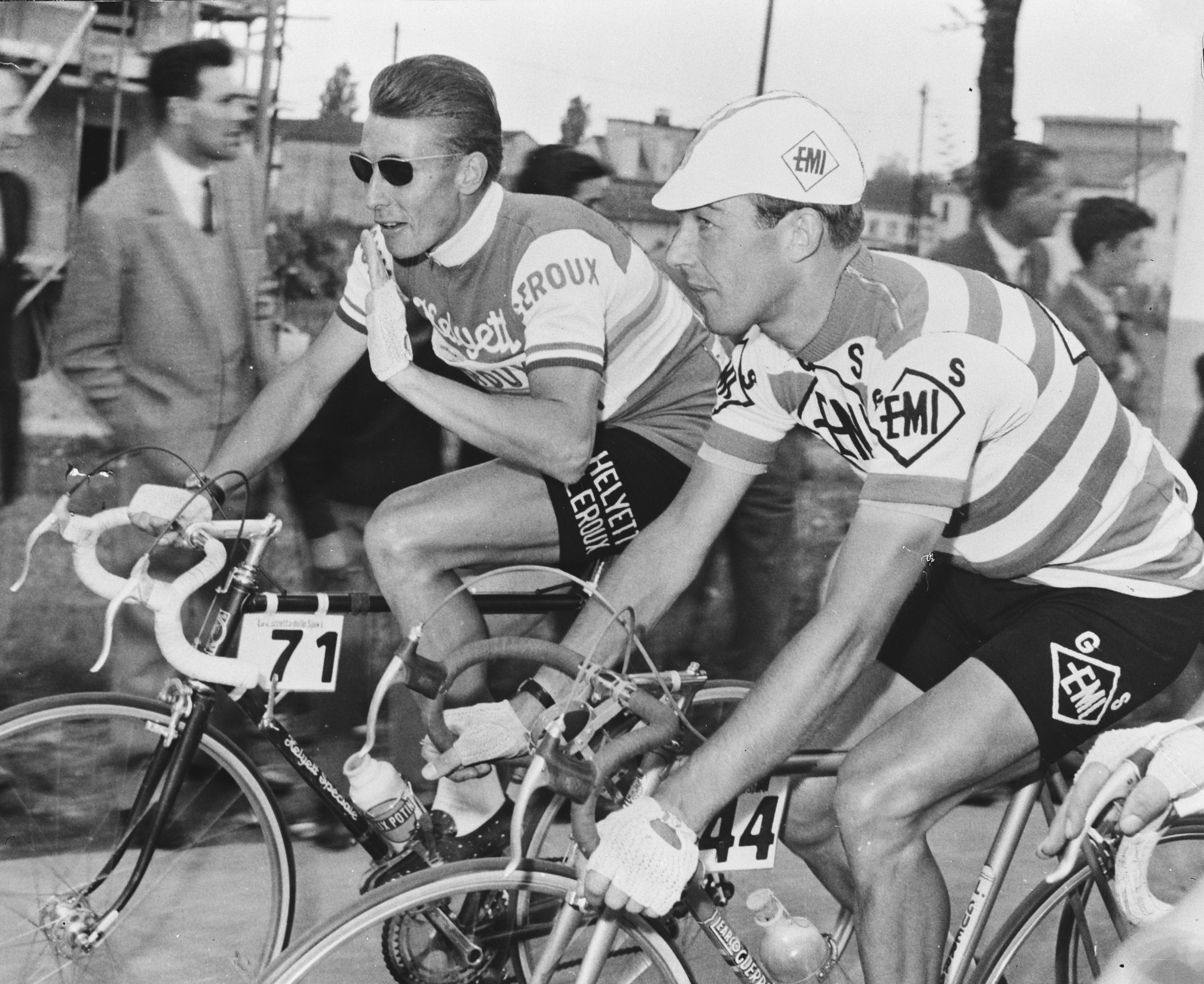|
1967 Tour De France
The 1967 Tour de France was the 54th edition of the Tour de France, one of cycling's Grand Tours. It took place between 29 June and 23 July, with 22 stages covering a distance of . Thirteen national teams of ten riders competed, with three French teams, two Belgian, two Italian, two Spanish, one each from Germany, United Kingdom and the Netherlands, and a Swiss/Luxembourgian team. The Tour was marred by the fatal collapse of Tom Simpson on the slopes of Mont Ventoux. The Tour de France was won by Roger Pingeon, member of the French national team that also won the team classification. The points classification was won by Jan Janssen, and the mountains classification by Julio Jimenez. Teams The previous years, the Tour had been contested by trade teams. Tour director Félix Lévitan held the team sponsors responsible for the riders' strike in the 1966 Tour de France, and therefore the formula was changed, and the national teams returned. The Tour started with 130 cyclists ... [...More Info...] [...Related Items...] OR: [Wikipedia] [Google] [Baidu] |
Roger Pingeon
Roger Pingeon (; 28 August 1940 – 19 March 2017) was a professional road bicycle racer from France. Biography Growing up near the Jura Mountains, he was a cross-country skier as a teenager before taking up bicycle racing. He spent two years in Algeria on military service before starting his professional cycling career relatively late. He raced as a professional from 1964 to 1974. In 1967, Pingeon won the Tour de France. In 1969, Pingeon won the Vuelta a España and finished second behind Eddy Merckx in the Tour de France.Roger Pingeon cyclingarchives.com He took a total of four Tour de France stage wins and finished in the top five of the race's general classification three times during his career. After retiring from competition he worked as a consultant for [...More Info...] [...Related Items...] OR: [Wikipedia] [Google] [Baidu] |
Algemeen Dagblad
The ''Algemeen Dagblad'' () or ''AD'' () (English: "General Daily Paper") is a Dutch daily newspaper based in Rotterdam, Netherlands. History and profile ''Algemeen Dagblad'' was founded in 1946. The paper is published in tabloid format and is headquartered in Rotterdam. Its regional focus includes the cities and regions around Rotterdam, Utrecht and The Hague. ''AD Rotterdams Dagblad'' * ''Goudsche Courant'' -> ''AD Groene Hart'' * ''Rijn & Gouwe'' -> ''AD Groene Hart'' * ''Haagsche Courant'' -> ''AD Haagsche Courant'' * ''Utrechts Nieuwsblad'' -> ''AD Utrechts Nieuwsblad'' * ''Amersfoortsche Courant'' -> ''AD Amersfoortsche Courant'' * ''De Dordtenaar -> ''AD De Dordtenaar'' * ''Dagblad Rivierenland'' -> ''AD Rivierenland'' Chief editors Het Vaderland ''Het Vaderland'' was an independent newspaper founded in the Hague in 1869. In 1972, it became a regional supplement of Algemeen Dagblad for The Hague. In 1982, the newspaper was dissolved. Circulation In the period of 199 ... [...More Info...] [...Related Items...] OR: [Wikipedia] [Google] [Baidu] |
Angers
Angers (, , ) is a city in western France, about southwest of Paris. It is the prefecture of the Maine-et-Loire department and was the capital of the province of Anjou until the French Revolution. The inhabitants of both the city and the province are called ''Angevins'' or, more rarely, ''Angeriens''. Angers proper covers and has a population of 154,508 inhabitants, while around 432,900 live in its metropolitan area (''aire d'attraction''). The Angers Loire Métropole is made up of 29 communes covering with 299,500 inhabitants (2018).Comparateur de territoire INSEE Not including the broader metropolitan area, Angers is the third most populous |
1967 Tour De France, Stage 1a To Stage 11
The 1967 Tour de France was the 54th edition of the Tour de France, one of cycling's Grand Tours. The Tour began in Angers with an individual time trial on 29 June, and Stage 11 occurred on 11 July with a mountainous stage to Digne. The race finished in Paris on 23 July. Stage 1a 29 June 1967 – Angers to Angers, (ITT) Stage 1b 30 June 1967 – Angers to Saint-Malo, Stage 2 1 July 1967 – Saint-Malo to Caen, Stage 3 2 July 1967 – Caen to Amiens, Stage 4 3 July 1967 – Amiens to Roubaix, Stage 5a 4 July 1967 – Roubaix to Jambes, Stage 5b 4 July 1967 – Jambes to Jambes, ( TTT) Stage 6 5 July 1967 – Jambes to Metz, Stage 7 6 July 1967 – Metz to Strasbourg, Stage 8 6 July 1967 – Strasbourg to Belfort/Ballon d'Alsace The Ballon d'Alsace german: Elsässer Belchen (el. 1247 m.), sometimes also called the Alsatian Belchen to distinguish it from other mountains named " Belchen" is a mountain at the border of Alsace, L ... [...More Info...] [...Related Items...] OR: [Wikipedia] [Google] [Baidu] |
Delpher
Delpher is a website providing full-text Dutch-language digitized historical newspapers, books, journals and copy sheets for radio news broadcasts. The material is provided by libraries, museums and other heritage institutions and is developed and managed by the Royal Library of the Netherlands. Delpher is freely available and includes as of June 2022 in total over 130 million pages from about 2 million newspapers, 900,000 books and 12 million journal pages that date back to the 15th century. Collections * ''Books:'' 900,000 books, from the 17th century onwards * ''Journals:'' 12 million journal articles from 1800-2000 * ''Newspapers:'' about 17 million pages from more than 2 million issues from the Netherlands, Dutch East Indies, Netherlands Antilles and Surinam, from 1618 to 2005. This represents about 15% of the total published newspaper output in the Netherlands in this period. * ''Typoscripts'' for radio broadcasts by the Algemeen Nederlands Persbureau The Algemeen Nederl ... [...More Info...] [...Related Items...] OR: [Wikipedia] [Google] [Baidu] |
Limburgs Dagblad
''De Limburger'' is a Dutch newspaper covering the province of Limburg. The ''Limburgs Dagblad'' merged into ''De Limburger'' at the end 2017. Both newspapers were owned by Mediahuis. ''Dagblad De Limburger'', the previous name of ''De Limburger'', was founded after a merger of ''Dagblad voor Noord-Limburg'' and ''De Limburger''. Merger history * ''De Limburger'' (since 2016) ** ''Limburgs Dagblad'' (1918–2017; gradually phased out) ** ''Dagblad De Limburger'' (1996-2016) *** ''Dagblad voor Noord-Limburg'' (18 April 1945 - 30 December 1995) (Northern Limburg) **** Continuation of: ''Nieuwe venlosche courant'' (1908-1944) (Venlo) ***** Formerly: ''Venloosch nieuwsblad - Venloosche courant'' ****** ''Venloosche courant: nieuw weekblad'' (1869-1908) ******* Continuation of: ''Nieuw Venloosch Weekblad'' ****** ''Venloosch Nieuwsblad'' (1898-1908) ******* Continuation of: ''Venloosch weekblad'' (1863-1898) *** ''De Limburger: Maas- en Roerbode'' (1 October 1971 - 30 December 1995) ... [...More Info...] [...Related Items...] OR: [Wikipedia] [Google] [Baidu] |
Col Du Galibier
The Col du Galibier (el. ) is a mountain pass in the southern region of the French Dauphiné Alps near Grenoble. It is the eighth highest paved road in the Alps, and recurrently the highest point of the Tour de France. It connects Saint-Michel-de-Maurienne and Briançon via the col du Télégraphe and the Col du Lautaret. The pass is closed during the winter. It is located between the massif d'Arvan-Villards and the massif des Cerces, taking its name from the secondary chain of mountains known as the Galibier. Before 1976, the tunnel was the only point of passage at the top, at an altitude of 2556 m. The tunnel was closed for restoration until 2002, and a new road was constructed over the summit. The re-opened tunnel is a single lane controlled by traffic lights, which are among the highest such installations in Europe. History In 1876 the first passable road was opened between Maurienne and Briançon in the Oisans region. In the north the pass road begins in Valloire, ... [...More Info...] [...Related Items...] OR: [Wikipedia] [Google] [Baidu] |
List Of Highest Points Reached In The Tour De France
The Tour de France is an annual men's multiple stage bicycle race primarily held in France, generally considered the most famous bicycle race in the world. It was founded by the French sports journalist and former professional road racing cyclist Henri Desgrange, who became the first director of the race. He was passionate about taking the Tour up to the highest reachable points of elevation in the Alps and Pyrenees using the most difficult routes. The highest point of the first Tour de France in 1903 was the summit of the Col de la République mountain pass in the Mont Pilat area of the Massif Central highland region. The following year the route remained identical, but in 1905 and 1906 the Tour moved into the Alps, in particular the Dauphiné Alps, and up to the Col Bayard at . The 1907 Tour took the race higher, up to with the Col de Porte in the Chartreuse Mountains. This point was again the highest for the next two Tours. The race first reached high altitude on ... [...More Info...] [...Related Items...] OR: [Wikipedia] [Google] [Baidu] |
Individual Time Trial
An individual time trial (ITT) is a road bicycle race in which cyclists race alone against the clock (in French: ''contre la montre'' – literally "against the watch", in Italian: ''tappa a cronometro'' "stopwatch stage"). There are also track-based time trials where riders compete in velodromes, and team time trials (TTT). ITTs are also referred to as "the race of truth", as winning depends only on each rider's strength and endurance, and not on help provided by teammates and others riding ahead and creating a slipstream. Individual time trial are usually held on flat or rolling terrain, although sometimes they are held up a mountain road (in Italian: ''cronoscalata'' "chrono climbing"). Sometimes the opening stage of a stage race is a very short individual time trial called a prologue (8 km or less for men, 4 km or less for women and juniors). Starting times are at equal intervals, usually one or two minutes apart. The starting sequence is usually based on the finishing times ... [...More Info...] [...Related Items...] OR: [Wikipedia] [Google] [Baidu] |
Prologue (cycling)
This is a glossary of terms and jargon used in cycling, mountain biking, and cycle sport. For ''parts of a bicycle'', see List of bicycle parts. 0–9 ; 27.5 Mountain bike: A mountain bike with wheels that are approximately in diameter and are based on ISO 584 mm (650B) rims. ; 29er (bicycle):A mountain bike with wheels that are approximately in diameter and are based on ISO 622 mm (700C) rims. ;3:1 rule : A UCI rule stating the depth and breadth (in cross-section) of the bicycle frame tubes cannot exceed the ratio of 3:1. A ; À bloc: Going ''À bloc'' means riding as hard as one possibly can, which can be risky as it leaves one in a state where recovery is needed, and therefore vulnerable to being attacked. ; Aero bars: Extension of the handlebars usually allowing the rider to rest their elbows and benefit from improved aerodynamics. Often found on Time trial bicycles. ; Aero racing bicycle: A type of racing bike that combines the aerodynamic features of a ti ... [...More Info...] [...Related Items...] OR: [Wikipedia] [Google] [Baidu] |
Marcel Bidot
Marcel Bidot (21 December 1902 – 26 January 1995) was a French professional road bicycle racer who won two stages of the Tour de France and became manager of the French national team. He led the team in 12 Tours and won six of them. Racing Marcel Bidot was the son of a failed café owner, a former racing cyclist who then ran one of the clubs in his home town of Troyes, in the Champagne region. His son, Marcel, worked for the Crédit Lyonnais bank in the town and rode for his father's club. He went training after work at 7pm. He turned professional in 1923 and at Alcyon earned 2,000 francs a month, ten times his pay at the bank. "At the time you could get a good meal for 20 francs and a newspaper for 25 centimes," he said. He rode every Tour de France from 1926 to 1930 and then again in 1932. His first was the longest of all Tours, at 5,745 km with a stage of 435 km from Metz to Dunkirk. The organiser, Henri Desgrange, forbade riders from accepting mechanical help af ... [...More Info...] [...Related Items...] OR: [Wikipedia] [Google] [Baidu] |
Lucien Aimar
Lucien Aimar (; born 28 April 1941) is a French cyclist, who won the Tour de France in 1966 and the national road championship in 1968. He is now a race organizer. He was born in Hyères, France. Amateur career Lucien Aimar came second in the Tour de l'Avenir in 1964, 42 seconds behind the Italian, Felice Gimondi. But for a one-minute penalty for an incident involving a Belgian rider, Aimar would have won. Later that year he rode in the individual road race at the 1964 Summer Olympics in Tokyo. Professional career 1965 Aimar turned professional in 1965 for Ford-Gitane, a team led by Jacques Anquetil. He made sufficient impression for the manager, Raphaël Géminiani, to pick him for the Tour de France in his first season. Aimar abandoned the race while climbing the Col d'Aubisque in the Pyrenees on the ninth stage. 1966 Aimar won Genoa-Nice at the start of the season, came second on the Flèche Wallonne and won the Tour de France. His victory was based on an attack on the A ... [...More Info...] [...Related Items...] OR: [Wikipedia] [Google] [Baidu] |






